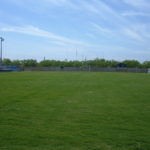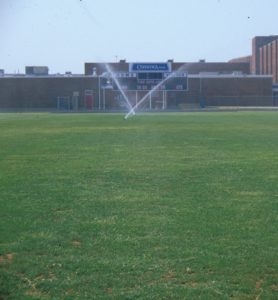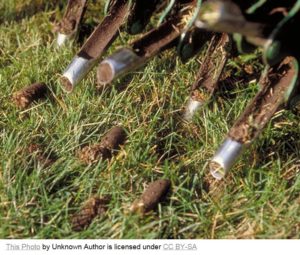
Over the summer is the time to prepare this field for the fall.
Summer management for both active and inactive sports fields is critical to maintaining healthy, safe fields year-round. Even just light maintenance can make a huge difference in what is possible when school starts again in the fall.
Irrigation

It’s a good idea to conduct an irrigation audit at least once a year to make sure you are watering the turf correctly.
To prevent surface hardness from creeping up to dangerous levels, regular irrigation is important – even for those fields that remain otherwise inactive during summer months. In many parts of the state where fields are constructed atop our trademark “shrinking and swelling” clays, the lack of irrigation can result in significant cracks in the field surface by the time football season is upon us. It can take a considerable amount of time and water to properly re-saturate the fields and bring them back to a safe surface capable of supporting healthy vegetation. Deep watering even once a week during dry periods can prevent this. Water early in the morning. This will optimize water use and prevent disease on your fields as fall approaches. Monitor and correct any malfunctioning irrigation. Uniform coverage will prevent dry spots where soil will harden and pests will move in. Consider a catch can audit.
Mowing
Raise the mowing height on fields that are less active in the summer. This will encourage deeper roots, improve water infiltration, and reduce weed encroachment during less active months. It will also reduce the risk of scalping when mowing is less frequent. In preparation for the coming year, mowing heights can be gradually reduced to those more acceptable for play. For shorter mowing heights, mow more frequently to prevent scalping. Never remove more
than 1/3 of the total height at a time.
Fertilization and Soil Amendments
Conduct a soil test by compiling multiple samples from across the entire field. Soil testing can be performed by the Texas A&M Soil, Water, and Forage Testing Laboratory . Use this as a guide for applying fertilizers or soil amendments over the summer when growth is more vigorous. Your goal should be to maintain the healthiest grass you can with the healthiest roots possible. A dense root system in the summer can make all the difference in the fall. Typically, between 2 and 6 lbs of N per 1000 ft2 is recommended per year for bermudagrass. These can be applied in 0.5 to 1 lb N per 1000 ft2 rates every 6 – 8 weeks during the growing season (May – Sept/Oct).
Aeration
Vigorous aeration will improve water infiltration, air flow, and stimulate root growth. Consider site-specific aeration of sports fields, where areas that are more likely to be compacted are aerated more aggressively. These are areas where foot traffic is heavier. Often, these areas can be identified by thinning turfgrass as well as poor water infiltration (pooling). Take care not to aerate too soon after a heavy rainfall event (can cause more compaction), or when conditions
are particularly hot and dry (can dry out the root zone).
Shallow or Deep?
Shallow-tine aeration can provide some nice short-term amelioration of soil compaction, and creates a sort of “direct line” to the root zone. This can be beneficial when coupling aeration with other maintenance such as fertilization or top-dressing. However, to truly stimulate deeper, denser roots, consider a more aggressive deep-tine aeration. Research has found that in more compacted systems (like sports fields), the roots will go as deep as the aeration. So, the deeper you go, the more benefits you will see for your root system. If core aeration is a regular part of your field maintenance (multiple times per year), consider varying tine depth to prevent the accumulation of a hardpan layer in the soil profile.
Solid or Hollow-Tine?

This is a solid-tine aerator.
For sports turf fields, the physical removal of soil cores is most likely to be advantageous in alleviating soil compaction and improving soil conditions. However, cleaning up extracted cores from the field can be tedious. Again, when aeration is a more frequent practice, consider alternating between different kinds of tines.
Follow the Texas Turf Program @AggieTurf (Twitter, Facebook, Instagram) for more turf tips.
Written By: Dr. Becky Grubbs, Turfgrass Extension Specialist & Assistant Professor

Come visit the AggieTurf website for more information.

 .
.